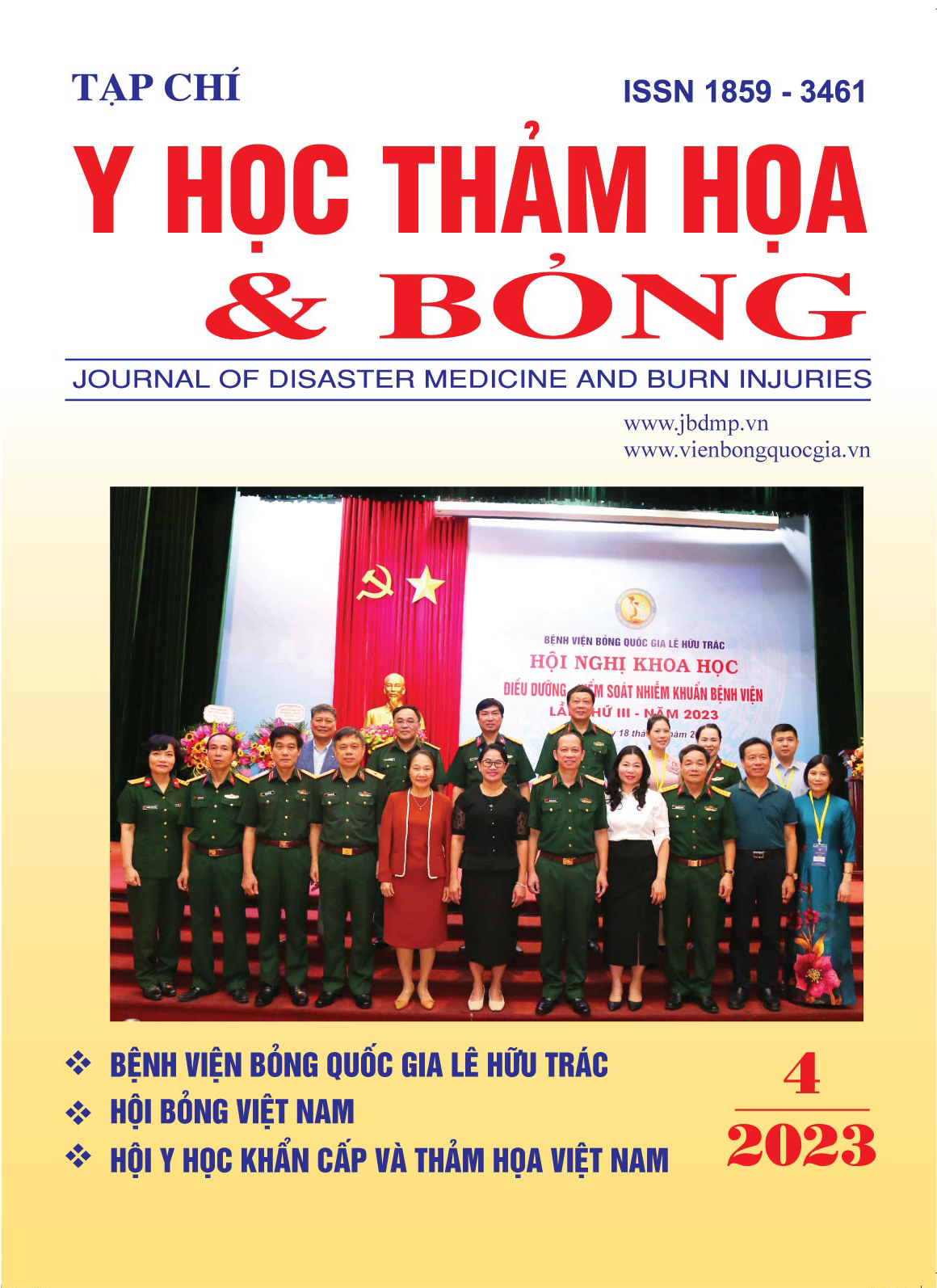Free flow-through anterolateral thigh flaps for wrist high-tension electrical burns: initial results
Main Article Content
Abstract
Introduction: High-tension electrical burns frequently involve the hand and wrist as these are the most common entry and exit points of the current. For patients with wrist vascular injury with skin and soft tissue defects, a variety of bridge flap blood flow is adopted to not only cover the wound but also restore blood circulation. However, there have been few reports on the use of flow-through anterolateral thigh perforator flap to repair the wrist blood flow for high-tension electrical burns.
Patients and Methods: Five patients with high-tension electrical wrist burns were admitted to Vietnam National Burns Hospital from August 2020 to August 2022. All 5 patients underwent wrist injuries after high-tension electrical burns and hand vascular crisis. The surgical plan was performed in two stages. For the first-stage operation, the wrist wounds were thoroughly debrided, the eschar was removed, and the necrosis in the tendons, muscles, and nerves of the wrist was cleared. The necrosis and the injured ulnar and radial arteries were removed up to the normal part of the blood vessel and the end of the blood vessel was temporarily clamped with a blood vessel clamp. For the second-stage operation, we designed the anterolateral thigh flap according to the soft tissue defect of the wrist. The location of the perforating branch(es) of the lateral circumflex femoral artery descending branch was determined using an ultrasound Doppler flow detector and marked. Dissecting of pedicle and elevating of flap, anastomosis of vessels. The outcomes were assessed after 6 months to one year of follow-up.
Results and discussion: All 5 patients were male, aged from 20 to 42 years old. The injury voltage and the patients were admitted to our hospital 20 to 58 days after the injury. The injury sites for all 5 patients were the wrists, specifically 4 right and 1 left wrists. The wounds led to the exposure and necrosis of the superficial and deep flexor tendons, flexor pollicis longus tendon, several muscles, pronator quadratus, median nerve, and ulnar nerve. Four patients had radial artery embolism necrosis. One patient had ulnar arterial embolization and necrosis. The range of the wound areas after debridement was 12 cm × 11 cm to 25 cm × 16 cm. The flap areas ranged from 14 cm × 14 cm to 28 cm × 18 cm and the length of the bridged blood vessel ranged from 12 cm to 24 cm. After 6 months to one year of follow-up, the shape of the flaps and blood flow in the hands were good. The shape of the thigh donor site was better restored, the thigh muscle strength was good, and the knee joint activity was regular.
Conclusion: Treating wrist high-tension electrical burns in clinical practice is still highly challenging. The use of flow-through anterolateral thigh flaps to restore the dual blood supply for the hand is a good choice for treating severe wrist electrical burns.
Article Details
Keywords
High-tension electrical burns, wrist flap surgery, free flow-through anterolateral thigh flaps
References
2. Lee DH, Desai MJ, Gauger EM. Electrical injuries of the hand and upper extremity. Ame Acad Orthop Sur, 2019; 27, e1-e8.
3. Shen ZY, Chang ZD, Wang NZ. Electrical injury of wrist: classification and treatment--clinical analysis of 90 cases. Burns, 1990; 16, 449-56.
4. Luan A, Galvez MG, Lee GK. Flow-through omental flap to free anterolateral thigh flap for complex chest wall reconstruction: case report and review of the literature. Microsurgery, 2016; 36, 70-6.
5. Miyamoto S, Fujiki M, Nakatani F, et al. Free flow-through anterolateral thigh flap for complex knee defect including the popliteal artery. Microsurgery, 2015; 35, 485-8.
6. Qing L, Wu P, Liang J, et al. Use of flow-through anterolateral thigh perforator flaps in reconstruction of complex extremity defects. J Reconstr Microsur, 2015; 31, 571-8.
7. Zhao JC, Shi K, Hong L, et al. Retrospective review of free anterolateral thigh flaps for limb salvage in severely injured high-voltage electrical burn patients. Ann Plas Surg, 2018; 80, 232-7.
8. Thomson CJ, Miles DA, Beveridge J, et al. Treatment of electrical burns by single debridement followed by free-flap coverage: How important is timing? Canada J Plas Surg, 2004; 12, 35-6.
9. Yokota K, Sunagawa T, Suzuki O, et al. Short interposed pedicle of flow-through anterolateral thigh flap for reliable reconstruction of damaged upper extremity. J Reconstr Microsurg, 2011; 27, 109-14.
10. Park KH, Park WJ, Kim MK, et al. Alterations in arterial function after high-voltage electrical injury. Critical Care (London, England), 2012; 16, R25.
11. Pannucci CJ, Osborne NH, Jaber RM, et al. Early fasciotomy in electrically injured patients as a marker for injury severity and deep venous thrombosis risk: an analysis of the National Burn Repository. J Burn Care Res, 2010; 31, 882-7.
12. Soutar DS, Scheker LR, Tanner NS, et al. The radial forearm flap: a versatile method for intra-oral reconstruction. British J Plas Surg, 1983; 36, 1-8.
13. Wang Y. Application of venous or arterial trunk free flaps in the treatment of severe wrist electrical burns. J Med Theory Prac, 2002; 15, 1289-90.
14. Hsiao YC, Yang JY, Chang CJ, et al. Flow-through anterolateral thigh flap for reconstruction in electrical burns of the severely damaged upper extremity. Burns, 2013; 39, 515-21.


